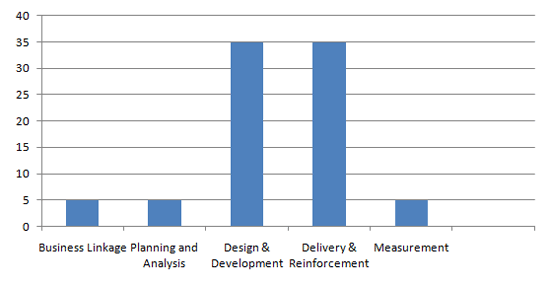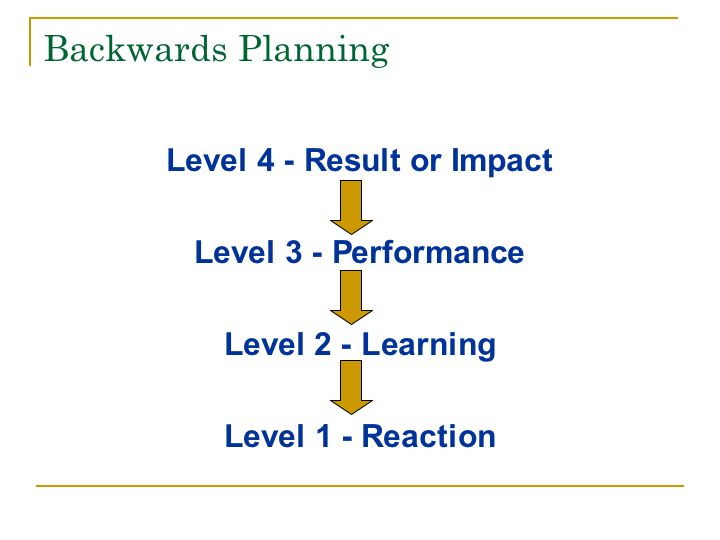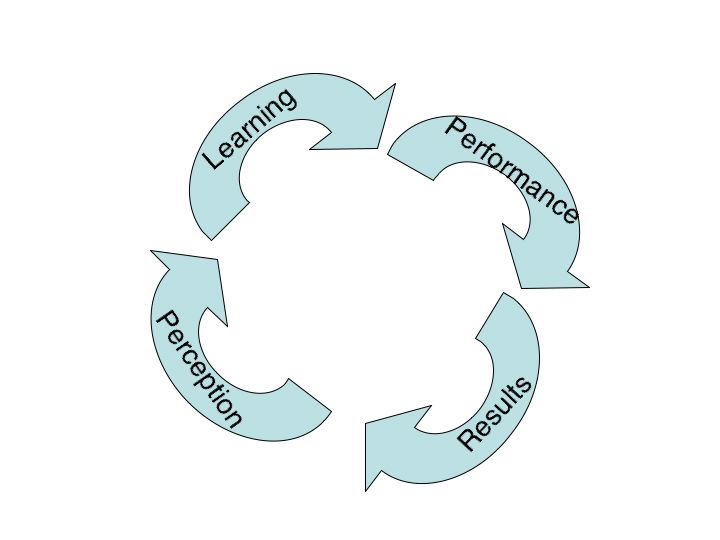If we learn how to do something, we have the capability to perform in a new way. For value to occur, we have to change our behavior and use the new capability in performance. Further, our performance must be aimed at worthwhile results — Brinkerhoff and Apking (2001).
The first step in performing
Backward Planning for Learning Initiatives is to determine the desired impact that will improve the performance of the business.
Business impacts (often called results or outcome) begin with the end in mind and are best achieved through "Business Linkage" — spelling out how a learning initiative supports the organization's initiatives, strategies, or goals (Garnevale, Gainer, & Villet, 1990). Business linkage is considered a "high value add", which is basically defined as the difference-making in business in that it adds high value. Yet linking learning initiatives to other business units is normally one of the activities that learning designers spend the least amount of time on (Trolley, 2006). We spend an enormous amount of time on designing and implementing our learning programs, but often fail to explain to our customers exactly how it impacts the organization.
For example, the chart below shows the average percent of time for creating a learning program (USMC Multimedia Guideline for Percentage of Development). As shown, most learning initiatives spend a lot of time on design and development, but very little time showing the customer how the learning platform adds value.

Even though the design and development of a learning initiative may takes a considerable amount of time, there must be additional effort expended to show your customers exactly how the learning initiative will benefit them (planning) and how it did help them (evaluating). Since each customer is different, you have to collaborate with them to ensure you know what their expectations are and how they would measure success. If customers do not see the learning initiatives benefiting them, then they are going to start picturing the Learning Department as a consumer of resources rather than a resource that produces assets.

Learning initiatives should always be undertaken to improve the performance of the business, thus they should always be defined in business terms. This does NOT mean you have to show an ROI (Return On Investment); however, there should be a clear causal link at the very least.
For example, frequent feedback to subordinates is normally considered a means for promoting better performance that should equate to higher profits (Wick, Pollock, Jefferson, Flanagan, 2006). A goal of having supervisors learning feedback skills is NOT a business outcome as it does not relate to a verifiable outcome that adds high value. A better business outcome would be the supervisors's subordinates will receive more frequent and better feedback as a result of the learning initiative. This gives a result than can be both measured and verified.
Learning departments have become pretty adept at selling their initiatives on features rather than benefits. For example, they will promote an elearning program as allowing the learners to read, listen, or do both. Yet in the majority of cases this is a feature rather than a real benefit; indeed, in some cases it is poor instructional design. Benefits, on the other hand, solve customers' needs by adding high value in one of two ways: increasing profits or lowering costs.
Anything that does doesn't support the business will be subject to intense scrutiny. What can't be articulated as driving business will be scrapped. - Rebecca Ray (2008)
Thus our first requirement as instructional designers is to ensure the learning initiative provides a real benefit to our customers. Only after this primary requirement has been met to we consider adding worthy features. In the book,
The Six Disciplines of Breakthrough Learning (2006), the authors list four questions that need to be asked before the design of a learning platform begins:
- What business need will be met?
- What will participants do differently and better?
- Who will be able to see and confirm these changes?
- How will you measure and document results?
Only after these questions are answered does the next step in the "Backwards Planning" process begin: the level of performance the learners must be able to do to create the business impact.
References
Brinkerhoff, R. O., Apking, A. M. (2001)
High Impact Learning. New York: Basic Books.
Garnevale, A., Gainer, L., & Villet, J., (1990), Training in America: The Organization and Strategic Role of Training. San Francisco: Jossey-Bass.
Ray, R. (2008). The Future of learning. Chief Learning Officer. Dec., 2008, p.21.
Trolley, E. (2006). Lies About Learning. Larry Israelite, ed. Baltimore, Maryland: ASTD.
Wick, C., Pollock, R., Jefferson, A., Flanagan, R., (2006). The Six Disciplines of Breakthrough Learning: How to Turn Training and Development Into Business Results. San Francisco: Pfeiffer.



























